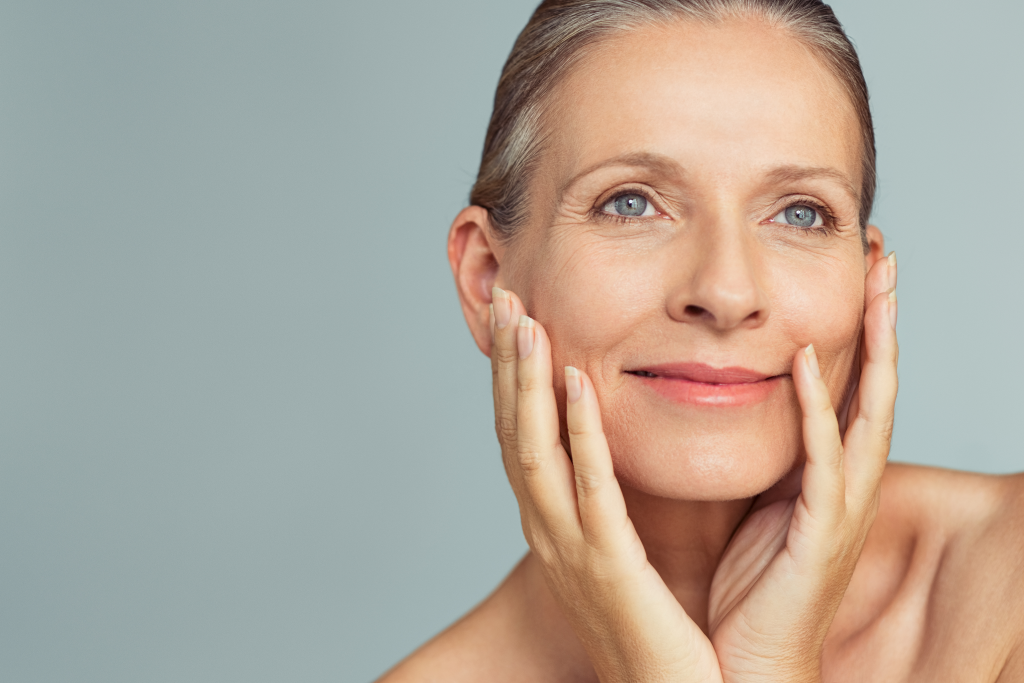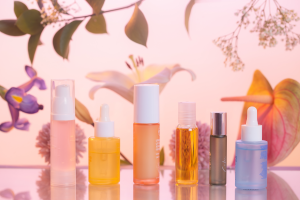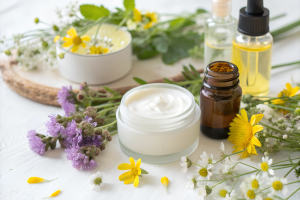
I know skincare can feel overwhelming, especially at an age when the skin begins to show signs of aging. But that is when it’s most vital to be mindful about the ingredients in your skincare products.
You grab a bottle off the shelf, skim the front label, see words like “natural,” “organic,” or “dermatologist recommended,” and figure you’re good to go. But here’s the thing: brands bank on us not flipping the bottle around and diving into that labyrinth of tiny words listed as ingredients. They exploit our trust. And while you’re busy hoping for clear skin, they’re slipping in stuff that can actually wreck the very skin you’re trying to save.

Which Harmful Ingredients To Avoid
Here are 10 ingredients you seriously need to avoid in skincare products, because nobody’s got time for toxic ingredients silently sabotaging their skin.
1. Parabens
Parabens are everywhere, in everything from lotions to shampoos, because they’re cheap preservatives. They’re sneaky little things that disrupt hormones, mimic estrogen, and confuse your body. Studies even link parabens to breast cancer cells, and yet brands keep tossing them in because they’re easy, and hey, profit margins are comfy when you’re not looking too close.
Check your labels for methylparaben, propylparaben, and butylparaben, and steer clear. Simple as that.
2. Phthalates
These are the chemicals that make plastic soft and fragrances last longer. Sounds harmless until you realize they’re endocrine disruptors, messing with your hormones, fertility, and even your thyroid. Oh, and they’re rarely listed outright. You’ll often find them hidden under “fragrance,” because fragrance is like skincare’s secret junk drawer—brands shove anything sketchy in there without disclosure.
Bottom line, ditch products heavy on artificial scents. Your skin doesn’t need to smell like strawberry fields anyway.
3. Formaldehyde
Formaldehyde shows up sneakily under names like DMDM hydantoin, Diazolidinyl urea, and Quaternium-15. It irritates the skin, triggers allergic reactions, and the International Agency for Research on Cancer labels it a known carcinogen. Imagine willingly spreading something that preserves dead tissue all over your face.
4. Sodium Lauryl Sulfate (SLS)
That rich, foamy lather you love so much in your cleanser—usually comes from SLS. It’s harsh, irritating, and strips your skin of natural oils, leading to breakouts, dryness, and redness. And guess what? It’s also a common pesticide ingredient. Congrats, your face wash is literally strong enough to kill bugs. Let’s not.
5. Triclosan
This antibacterial chemical found in cleansers, soaps, and deodorants sounds helpful until you realize it messes with thyroid hormones and fosters antibiotic-resistant bacteria. The FDA banned it from hand soaps years ago, but somehow it still lurks in skincare and toothpaste. Logic at its finest, right? Just ditch it.
6. Petroleum Jelly (Petrolatum)
Look, petroleum jelly has its fans. It locks moisture in, sure, but it also locks dirt, bacteria, and toxins underneath it. It creates a fake barrier that suffocates your skin. Plus, unless it’s super refined—and let’s be honest, most brands go cheap—it could be contaminated with carcinogens. Your pores deserve better than petroleum byproducts, trust me.
7. Synthetic Colors (FD&C, D&C)
Artificial colors look pretty, but these dyes are often coal tar derivatives. Coal tar itself is a known carcinogen, and dyes like FD&C Red 40 or Yellow 5 come with heavy-metal contaminants. They irritate skin, trigger allergies, and can mess with your nervous system. Bright pink lotion might feel fun, but the consequences definitely aren’t.
8. Oxybenzone
Commonly lurking in sunscreens, oxybenzone acts like estrogen and messes with your endocrine system. It’s also a known allergen, causes skin irritation, and contributes to coral reef damage. So, not only is it harming your body, it’s literally destroying entire ocean ecosystems. Safe bet? Stick to mineral sunscreens, skip chemical sunscreens entirely.
9. Alcohol (Denatured Alcohol, Isopropyl Alcohol)
Alcohol makes your moisturizer feel lightweight, evaporating quickly. Problem is, it evaporates your skin’s natural moisture right along with it. Over time, alcohol destroys your skin’s protective barrier, causing dryness, flakiness, and irritation. It might feel refreshing at first, but trust me, your skin’s cursing you every time you slather it on.
10. Fragrance
We’ve gotta talk about fragrance again. It’s the loophole ingredient. Companies don’t have to disclose what’s actually in their fragrance. That means it can contain hundreds of chemicals, allergens, irritants, and yes, hormone disruptors. Synthetic fragrances can irritate your skin, trigger migraines, worsen asthma, and upset your hormones. Honestly, fragrance is skincare’s dirty little secret, and brands know exactly what they’re doing.
Instead, opt for products labeled fragrance-free or scented only with essential oils—and make sure you’re not sensitive to those either.
Here’s the thing. Brands will always find ways to dance around the rules, hoping you’ll trust flashy ads, cute packaging, or buzzwords like “clean” and “natural.” But skincare is about health, safety, and knowing exactly what you’re smearing onto your largest organ.
So get into the habit of flipping those bottles around and reading labels carefully. You wouldn’t drink toxic chemicals willingly, so why let your skin absorb them every single day?

What To Use Instead
So what can you actually trust to put on your skin without it rebelling against you? Fair question. Here’s a list of ten alternatives that you can use without damaging your skin.
1. Swap Parabens for Natural Preservatives:
Look for skincare preserved with vitamin E (tocopherol), rosemary extract, or grapefruit seed extract. They’re effective without messing up your hormones or inviting health scares.
2. Replace Phthalates with Essential Oils:
Natural essential oils add fragrance safely. Think lavender, tea tree, or chamomile. But heads-up, essential oils can be potent, so always patch-test first and ensure they’re pure—not synthetic fragrances disguised as natural.
3. Formaldehyde-Free Preservatives:
Opt for safer alternatives like sodium benzoate or potassium sorbate. Both are gentle, effective, and won’t remind you of embalming fluid every time you moisturize your face.
4. Ditch SLS for Coco Glucoside:
If you crave a foamy cleanse minus the pesticide vibes, choose coco glucoside or decyl glucoside. Derived from coconut oil and fruit sugars, these surfactants cleanse without stripping your skin’s natural oils.
5. Replace Triclosan with Tea Tree Oil:
Tea tree oil naturally fights bacteria, acne, and inflammation without breeding antibiotic-resistant superbugs. It’s powerful stuff, but dilute it to avoid irritation.
6. Petroleum Jelly Alternative – Beeswax or Shea Butter:
Both beeswax and shea butter create a breathable, protective barrier without trapping impurities. Plus, they’re packed with nourishing vitamins that petroleum jelly just can’t match.
7. Skip Synthetic Colors, Use Natural Pigments:
For a safer color kick, opt for products tinted naturally with beetroot powder, turmeric, or mica. Your skin gets subtle hues minus the toxins, irritation, or mystery metals.
8. Oxybenzone-Free Sunscreens:
Mineral-based sunscreens with zinc oxide or titanium dioxide protect your skin effectively without harming ocean life or disrupting your hormones. They’re gentle and reef-friendly, no compromise needed. Click here for a favorite sunscreen of mine!
9. Choose Alcohol-Free Formulas:
Look for moisturizers containing plant-based hydrators like aloe vera, glycerin, or hyaluronic acid instead of drying alcohol. Your skin stays hydrated, healthy, and doesn’t secretly resent you.
10. Go Fragrance-Free or Natural:
Choose unscented products or ones lightly scented with real essential oils clearly listed on the label.
Stay Mindful, Keep Your Skin Nourished
You’ll discover that your skin will show you gratitude pretty quickly once you stop smothering it in toxic chemicals disguised as self-care.
Skincare should nourish you, not stress you out. Swap toxic ingredients for these straightforward, healthier options and notice the difference—not just on your skin but in your peace of mind.
Start reading labels, demand transparency, and don’t settle for anything less. Your skin deserves honesty, clarity, and care—real care.

Hi Alison – I always learned so much from your posts! I am always trying to be aware of toxins and whatever I consume or whatever I expose my body to. With that said, I don’t know what to look for and your thoughts in this post are very important. I am so thankful that there are people like you who have studied and are subject matter experts so that the rest of us can be mindful of what we choose to do. I don’t really use lotions or other skin products other than sunscreen, but I am a big face washer, and I will be mindful to review the ingredients from now on. Thank you very much for your post!
This was such a wake-up call! 😳 It’s crazy how many of these toxic ingredients are hiding in everyday products—like, why is my face wash basically a bug killer?! Love how you broke everything down in a no-BS way, and the swaps make it so easy to ditch the junk. Definitely checking my labels ASAP! Thanks for this, my skin (and sanity) appreciate it!
Hi Alison,
Lately, I’ve been diving deeper into skincare, especially now that I’ve just turned 50. I’ve always been mindful of my routine, but this post really highlighted just how important it is to pay attention to ingredients, especially the ones I’ve been trying to avoid for years. It’s wild how many sneaky additives are in everyday products! I’m definitely going to make even more of an effort to read labels and choose the healthier, more natural options you mentioned. Thanks for the helpful tips!
Meredith
Alison, This breakdown of harmful ingredients is incredibly useful, especially for someone like me who’s trying to be more mindful about health. I’ve been focusing on improving my overall well-being, but skincare has always felt overwhelming with all the marketing tricks brands use, plus I don’t think many men think about this stuff! The way you listed out each toxic ingredient along with easy-to-understand explanations makes it simple to know what to avoid. I also appreciate the alternative suggestions—having a clear guide on what to use instead makes switching to healthier options much easier. This is a great reminder to start checking labels more carefully and prioritise what actually benefits you the most.